|
Location: Adams County,
Ohio, USA. |
Grid Reference:
39� 1′ 33.09″ N, 83� 25′ 49.60″ W |
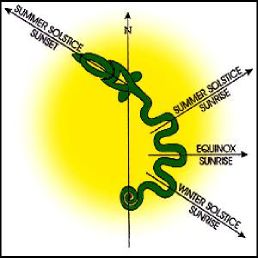
 Serpent Mound:
Serpent Mound:
The Serpent Mound in
Ohio is the largest physical serpent effigy mound in the world.
While there are several burial mounds around the Serpent mound site,
the monument itself does not contain any human remains and the
structure itself is therefore now primarily recognised as an astronomical observatory.
The Serpent was recently named by National Geographic as one of the
four �Sacred Places of the World� and is also a U.S. nominee to the
UNESCO World Heritage sites.
Of all the
prehistoric American mounds that have survived the test of time, the
serpent mound is one of the most intriguing. In addition to the
presence of the mound itself and the debate over the meaning of the
'egg' feature in its mouth, it was built overlooking a massive impact crater, which adds more myth than answers to the
legend of the Great Serpent Mound.
|
The Great Serpents Mound: |
The Serpent varies in height from less than a foot at its spiral beginning to more than three feet at its highest points. The serpent winds back and forth for more than eight hundred feet and seven coils, and ends in a triple-coiled tail. The serpent head has an open mouth extending around the east end of a 120-foot (37 m) long hollow oval feature.
This oval is said to possibly symbolize several things:
A primordial egg, the sun, the body of a frog, the universe or
merely the remnant of a platform. Of course, it is not
conclusively known what its purpose is, but that only adds to
its beautiful mystery.
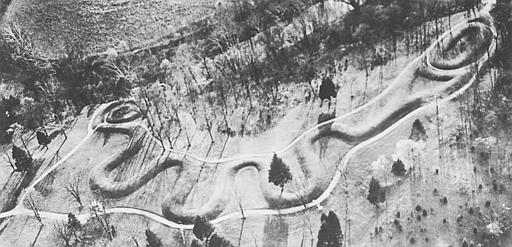
The Great Serpent Mound is a 1,348-foot (411 m)-long, three-foot-high prehistoric effigy mound.
It is not known which culture exactly is responsible for the
original construction of this magnificent Mound, but there are several clues we can use to deduce its makers. It is
clear that many different cultures adapted this structure for their own needs, but who created it.?
Researchers have attributed construction of the mound to three different prehistoric indigenous cultures. Although it was once thought to be Adena in origin, now based on the use of more advanced technology, including carbon dating and evidence from 1996 studies, many scholars now believe that members of the Fort Ancient culture built it about 1070 CE (plus or minus 70 years).
FORT ANCIENT CULTURE:
Well known for mound building across Ohio, many Scholars believe the Fort Ancient culture created these mounds in 1070
B.C. However, this proto-historic group could have simply restored the Mounds after a prior culture may have abandoned them.
The Fort Ancient culture was named for was named because they inhabited warren County Ohio, and were believed to have created the ramparts of the large notched earthworks known as Fort Ancient. After more research, it was discovered that they simply inherited Fort Ancient from the Hopewell culture at least 1000 years before the Fort Ancient culture. (7)
This suggests the Hopewell culture may have in fact created Serpents mound, but more conclusive evidence is needed.
ADENA CULTURE:
The Adena Culture (1000 B.C � 1 A.D) was the first believed progenitor of
the Great Serpents mound, although it shows no similarity to other Adena structures, which are predominantly geometric in design.
This culture was suspected of creating the mounds due to several burial mounds nearby that housed Adena remains, but this theory was refuted due to Carbon-dating which placed the date of the mounds farther back than this group.
More important than the actual creation of these mounds, is the fact that several cultures used them for cosmological purposes. The Allegheny, Hopewell, Fort Ancient and Adena cultures drew intimate significance from their Earth works. All cultures had
artefacts found in or near the mounds, but a conclusive answer has eluded us to this day.
( More About the
American Mound Builders)
Article: Giant Skeletons
Found At Serpent mound: (New York Times. March 5, 1894).
'Giants of Other Days: Recent Discoveries near
Serpent Mound, Ohio' From the Indianapolis Journal.
'Farmer
Warren Cowen of Hilsborough, Ohio, while fox hunting recently
discovered several ancient graves. They were situated upon a
high point of land in Highland County, Ohio, about a mile from
the famous Serpent Mound, where Prof. Putnam of Harvard made
interesting discoveries. As soon as the weather permitted, Cowen
excavated several of these graves. The graves were made of large
limestone slabs, two and a half to three feet in length and a
foot wide. These were set on edge about a foot apart. Similar
slabs covered the graves. A single one somewhat larger was at
the head and another at the foot. The top of the grave was two
feet below the present surface.
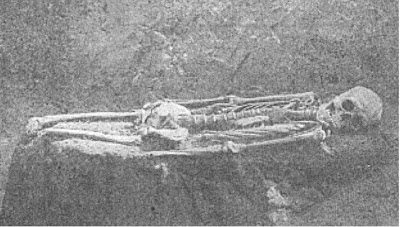
Upon opening
one of the graves a skeleton of upwards of six feet was brought
to light. There were a number of stone hatchets, beads, and
ornaments of peculiar workmanship near the right arm. Several
large flint spear and arrow heads among the ribs gave evidence
that the warrior had died in battle.
In another
grave was the skeleton of a man equally large... Several pipes
and pendants were near the shoulders. In other graves, Cowen
made equally interesting finds. It seems that the region was
populated by a fairly intelligent people, and that the serpent
mound was an object of worship. Near the graves is a large field
in which broken implements, fragments of pottery, and burned
stones give evidence of a prehistoric village'.
(Other
Giant Skeleton Discoveries)
It is generally
accepted today that the Serpent mound was designed to view celestial precession, one of the best places to do so is the head of the Snake.
But the coils of the snake are predominantly Lunar in their
orientation, capturing the full 18.6 year cycle. It is now suggested
that the monuments was orientated for both Solar and Lunar
observations.
In 1987 Clark and Marjorie Hardman published their finding that the oval-to-head area of the serpent
(facing the crater) is aligned to the summer solstice sunset (3). The head of the serpent is aligned to the summer solstice sunset and the coils also may point to the winter solstice sunrise and the equinox sunrise (4). The body of the snake is marked by several points of reference for different celestial Phenomenon as seen by the signs below:
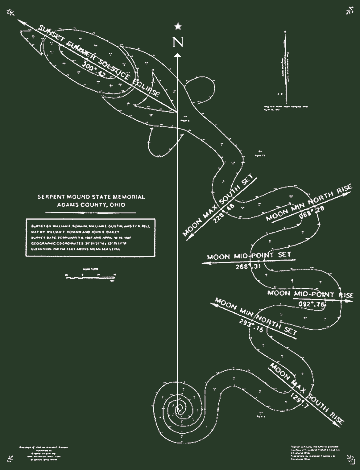
Diagram to Illustrate the Astronomical Significance of Serpent
Mound.
The year the Mounds
are expected to have been created was in 1070
BC, and there were two significant astronomical occurrences that may have inspired their construction: The light from a Supernova that created the Crab Nebula in 1054, and the appearance of Halley�s Comet in 1066.
The light from the supernova would have been visible in the night sky and the daytime, (5) but of course there
are a multitude of other celestial phenomenon that could have inspired this magnificent Ancient Effigy.
Another common cosmic theme is that Serpents mound is aligned to Draco. Draco is a featured constellation in a plethora of other cultures, and the harmony is definitely seen at Serpents mound.
The pattern of Stars in the constellation Draco fits precisely to the Mound, with the ancient Pole Star, Thuban at its geographical centre within the first of seven coils from the head.
(More about
Archaeoastrronomy)
|
The Serpent Mound Crater: |
The Great Serpent mound is placed on a plateau overlooking a unique
5-mile diameter circular "cryptoexplosion" area with its
own gravity and faulted and folded bedrock. Since there are no volcanoes in the region, it
is generally accepted to have been caused by a cosmic encounter. So
great was the impact that scientific instruments have measured
gravitational and magnetic anomalies at Serpent Mound which show
that the natural forces in the area deviate because of the
subsurface disruption. (2)
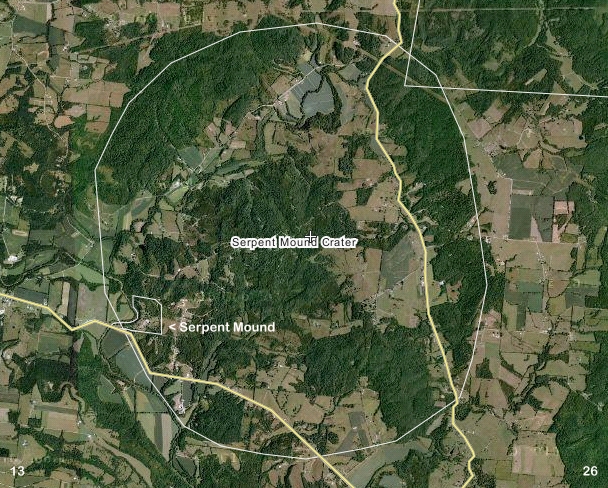
A press release on December 16th 2003 stated geologists from Ohio State government and the University of Glasgow (Scotland) concluded that a meteorite strike was responsible for the formation.
They became convinced of the meteorite theory after studying deep rock and mineral core samples collected at the site in the 1970s. Further analyses of the rock core samples recovered at the site indicated the meteorite impact occurred during the Permian Period, about 248 to 286 million years ago. During that period, geologists believe the modern-day continents were fused together into a single super-continent called Pangaea, and the area of present-day Ohio lay just south of the equator.[8]
This location is one of the few places in North America where such an occurrence is seen. Of course, there is speculation that whoever built these mounds did so purposely to correlate to the impact zone, while others believe there is no coincidence.
"The people who have looked at the samples
are sure. It's one of the most mysterious places in North
America. The Native Americans found something mystical there.
And they were right." -Raymond R.
Anderson of the Iowa Department of Natural Resources (2)
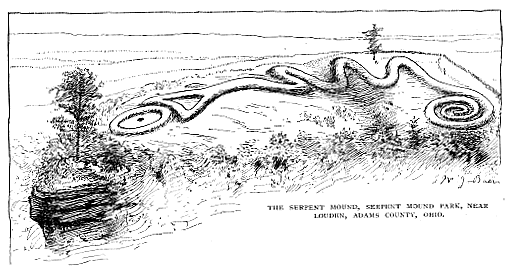
The Head of the Monument Overlooks the Impact
Crater.
The journey along the Serpent mound begins at the tail. When you approach the mounds, the first thing that you witness is a perfect spiral.
This spiral feature is a well noted phenomenon around the ancient world. There
are several good examples in the America's, most notably those at
Nazca and
Chaco Canyon. Although the original significance of the
spiral and labyrinthine form are lost to us now, they are commonly
suggested to be related to the 'inner journey'.
Service and Bradbery (9), write that the spiral refers to:
'...the belly and navel (Neumann 1955). It is also seen as representing a Navel of the earth - the Omphalos...E.A.S Butterworth in 'The Tree at the Navel of the Earth' calls it the Omphalos sign...now seen as very ancient and very widespread (Roscher 1913), This fits well into the idea of megalith as places of interchange between the cosmic forces of the sky and earth'. 10
(More
about Spirals)
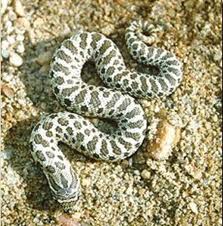 Walking from the Spiral along the serpent body is a peaceful
and contemplative experience. The farther you walk along the Serpent, the more astronomical observatories you encounter. The
undulations of the serpents body were designed to be orientated such that they
align with the most significant moments of the Lunar and Solar calendars on both sides:
While today many of these alignments are obscured by trees, in its original form
and with the lines of sight cleared, the monument would have once been able to
operate as a calendar for both cycles (Metonic). Walking from the Spiral along the serpent body is a peaceful
and contemplative experience. The farther you walk along the Serpent, the more astronomical observatories you encounter. The
undulations of the serpents body were designed to be orientated such that they
align with the most significant moments of the Lunar and Solar calendars on both sides:
While today many of these alignments are obscured by trees, in its original form
and with the lines of sight cleared, the monument would have once been able to
operate as a calendar for both cycles (Metonic).
The Snakes head: Some say the serpent has an 'egg' in its mouth, while others
say it is 'Eating the Sun'.
The head is aligned to the summer solstice sunset, and acts as a wonderful observatory to view the solar precession.
Facing away from the Cosmic egg and Serpent head, there is a platform that provides the most breathtaking view of the Impact area below.
It seems likely that both the location of the mound and its design (the 'egg' it
carries in its mouth), are both connected in some intricate way to the crater
over which it lies coiled.
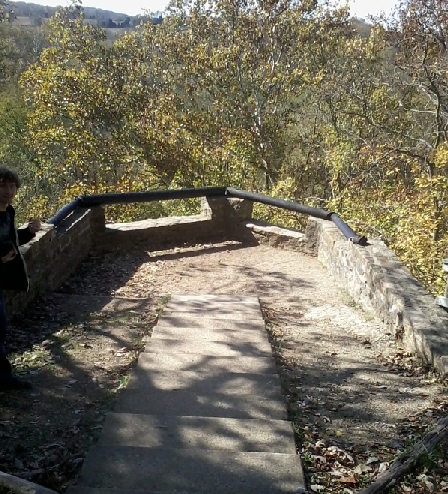
The Currently Obstructed View of
the Crater (Photo Credits: Zakk
Whitman)
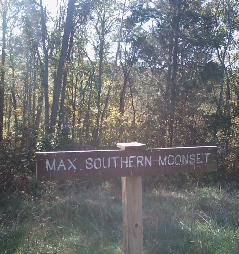
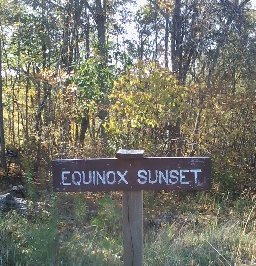
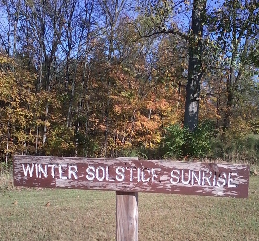
The close woodland
around the site prevents the astronomical events to be properly
witnessed today.
(Photo Credits: Zakk
Whitman)
The
Serpent Mound Tunnels:
If you ever go to serpents mound, a short walk along the trails leading away from the mounds will take you directly under the rock face of the mounds.
Walking along the path below the mounds and deep into the sides of the bedrock, are
numerous small "tunnels" into the rock. Some of the holes go into the bedrock very deep. It�s unknown how these holes were made,
although it is loosely suggested that they originated from a
prehistoric underground gas explosion. It is entertaining to think
that they might have been associated in some way with snakes.
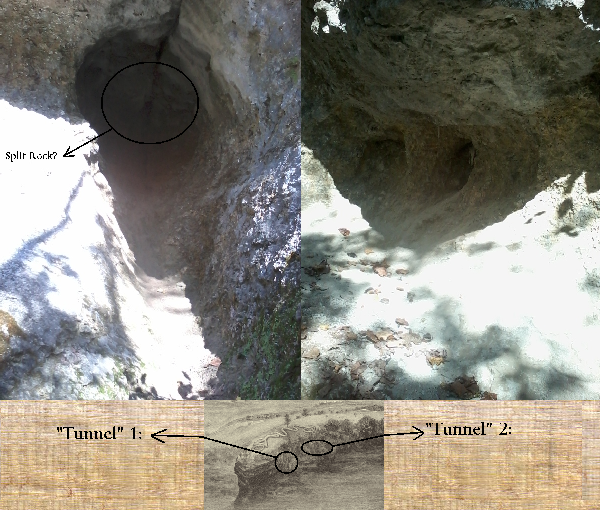
(Photo Credits: Zakk Whitman)
Anomalies of the tunnels are the large crack in roof of the first tunnel, and a large "monolith" resting at the bottom of the large tunnel
(below).
It's presence suggests a purpose is unknown.
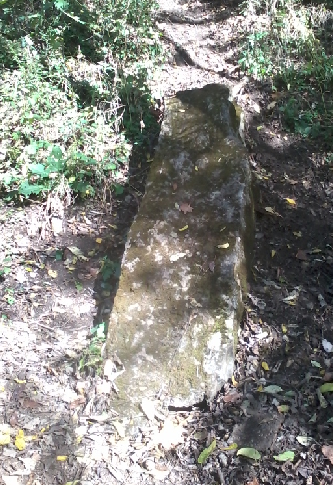
(Photo Credits: Zakk Whitman)
Additional to the World-wide
reverence to Serpents, the Americas have a similar reverence for Serpents that
spans multiple cultures. The Cherokee have the legend of the Uktena, a
large serpent with supernatural appearance and power. A similar snake-deity is
found in ancient African and Australian aboriginal mythologies.
Here are several North American Serpent deity names:
Misi-kinepikw ("great snake")�Cree
Msi-kinepikwa ("great snake")�Shawnee
Misi-ginebig ("great snake")�Oji-Cree
Mishi-ginebig ("great snake")�Ojibwe
Pita-skog ("great snake")�Abenaki
Sinti lapitta�Choctaw
Unktehi or Unktehila�Dakota
Olobit�Natchez
Uktena�aniyunwiya
It is unknown whether this site was
inspired by the same origins, but
the earliest known form of serpent worship extends back to 70,000 B.C. to the Sanpeople of Africa.
There are several other earthworks around the
ancient world which feature serpents.
Most notably, the following:

Otonabee Serpent mound, Ontario, Canada: (Note the similar
'Egg shape')

Loch Nell, Scotland.
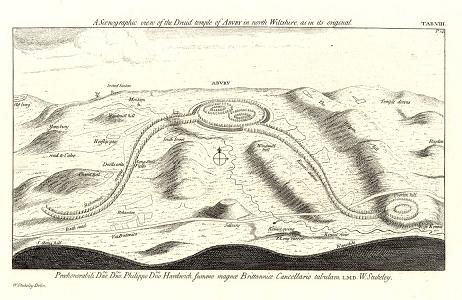
Stuckley's view of the
Avebury/Silbury Complex, England.
(The Mound
Builders)
(Altered
Landscapes)
(Ancient
America's Homepage)
|






 Walking from the Spiral along the serpent body is a peaceful
and contemplative experience. The farther you walk along the Serpent, the more astronomical observatories you encounter. The
undulations of the serpents body were designed to be orientated such that they
align with the most significant moments of the Lunar and Solar calendars on both sides:
While today many of these alignments are obscured by trees, in its original form
and with the lines of sight cleared, the monument would have once been able to
operate as a calendar for both cycles (Metonic).
Walking from the Spiral along the serpent body is a peaceful
and contemplative experience. The farther you walk along the Serpent, the more astronomical observatories you encounter. The
undulations of the serpents body were designed to be orientated such that they
align with the most significant moments of the Lunar and Solar calendars on both sides:
While today many of these alignments are obscured by trees, in its original form
and with the lines of sight cleared, the monument would have once been able to
operate as a calendar for both cycles (Metonic). 







